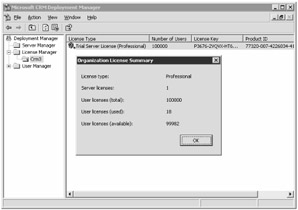Users and Licenses
A user is someone with access to Microsoft CRM and typically works for your organization. Before you can add and configure users, you must add user accounts to Active Directory. To manage users in Microsoft CRM, browse to Business Unit Settings in the Settings area, and click Users. For each user, you must complete the following security-related tasks:
-
Assign one or more security roles to the user.
-
Assign the user to one business unit.
-
Assign the user to one or more teams.
The combination of these three settings determines a user's access to information in Microsoft CRM.
| Note | Although most of your users will be employees of your organization, you can create user accounts for trusted third-party vendors or suppliers if you want to grant them access to your system. Obviously, you should carefully structure the business units and security roles to make sure that third-party users don't see information that you don't want them to view. |
Every user that you add to Microsoft CRM automatically counts against the number of Microsoft CRM licenses that you purchased, with one exception. If you select the Restricted Access Mode check box on a user record, that user can perform administrative functions within Microsoft CRM such as changing settings and customizations, but the user will not count as an active licensee because he or she cannot access any of the sales, service, or marketing functions.
When a user stops working with your Microsoft CRM deployment, you should disable the user's record by clicking Actions, and then clicking Disable on the user record menu bar. To maintain data integrity, Microsoft CRM does not allow you to delete users. Disabling a user will not change his or her record ownership because disabled users can still own records.
| Tip | If you change a user's business unit, Microsoft CRM removes all of that user's security roles because roles vary by business unit. In such a situation, remember to grant the user security roles again; otherwise, he or she won't be able to log on to Microsoft CRM. |
If you want to view a summary of your current active licenses, launch the Microsoft CRM Deployment Manager on the Microsoft CRM Web server, and then click License Manager. Right-click a license and select License Summary (shown in Figure 3-4).

Figure 3-4: License summary in Microsoft CRM Deployment Manager
EAN: 2147483647
Pages: 120
- Chapter II Information Search on the Internet: A Causal Model
- Chapter IX Extrinsic Plus Intrinsic Human Factors Influencing the Web Usage
- Chapter X Converting Browsers to Buyers: Key Considerations in Designing Business-to-Consumer Web Sites
- Chapter XIII Shopping Agent Web Sites: A Comparative Shopping Environment
- Chapter XVIII Web Systems Design, Litigation, and Online Consumer Behavior